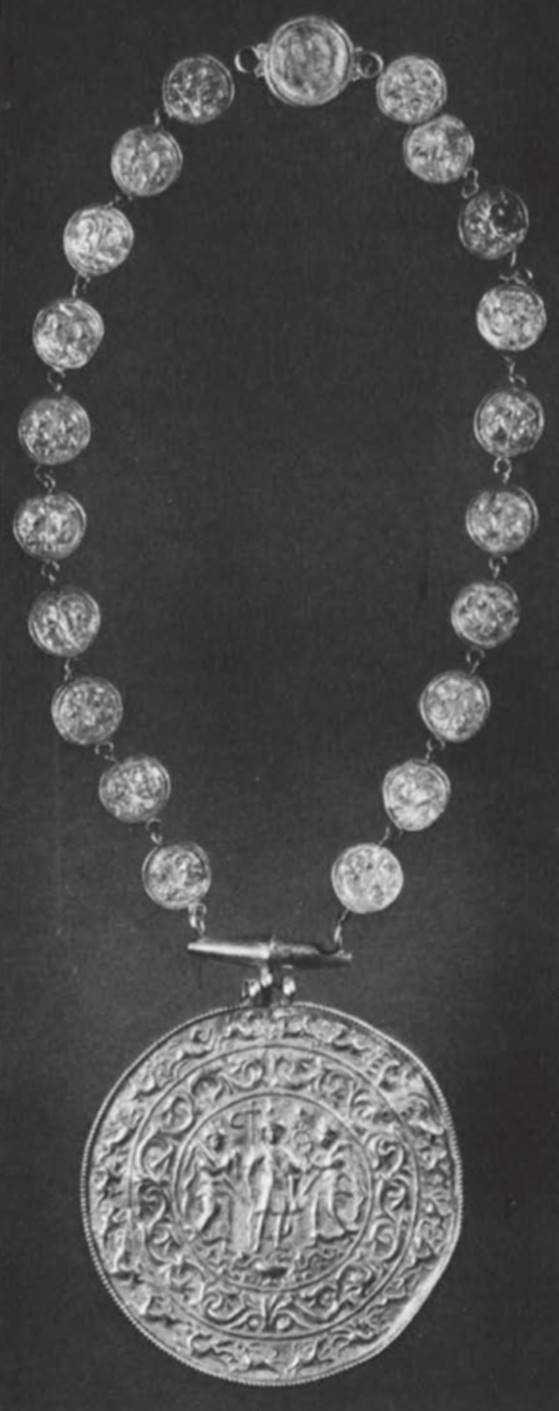Encolpion with crowning of an emperor. Constantinople or Cilicia (?), late 6th century. Gold
A necklace made of one plain and twenty identically stamped discs connected by loops, some of which are modern, supports from an elongated biconical hinge a large gold medallion. Pressed from thin sheets of gold, the necklace imitates jewelry made up of solid medallions and coins set into separately worked frames (e.g., nos. 295, 296).
The central image on the medallion represents an emperor holding an orb in his covered left hand and a long, cross-topped spear in his right. He is flanked by two female personifications: the sun to his left, with radiate crown, offering him a crown or torque; the moon to his right, with crescent crown and hands covered with a cloth and extended in an attitude of adoration. Each carries a lighted torch over her shoulder and is accompanied by a further symbol of her identity—a starlike sun and a crescent moon. A hand descends from the sky proffering another crown; in the exergue is a vase with ropelike vines trailing from it.

The inner of two concentric bands is filled with a thick fluid vine scroll, the outer with sketchy, energetically rendered running animals. Fine beading rims the medallion.
The small medallions, each encircled by beading, show two frontal busts flanking a long, narrow cross. The word VTTA (vyisia—"health") is below.
Grabar ([1] 1951) explained the prophylactic intention of the overall program of animal frieze, crosses, and inscription. He demonstrated an iconographical connection between the central image and Constantinian formulae of the fourth century, suggesting that a storehouse of somewhat old-fashioned patterns was still used in a Cilician atelier (Grabar, 1962). Grabar (1962) also attributes the unusual personification of Sol as a female to a break in the antique tradition in such a provincial center of production.
Although the small medallions may be early examples of constantinata, as Grabar maintained ([1], 1951), they also bear a formal resemblance to marriage rings (Ross, 1965, II, nos. 51, 52, 67, 68) which the inscription would support (Ross, 1965, II, no. 38). The imagery of emperor, sun, and moon —traditional motifs even before Constantine's time—may also reflect, in its reformed Christian context, contemporary ideas related to the marriage rite (Kantorowicz, 1960).
The necklace was part of a treasure discovered near Mersine, ancient Zaphyron, in Cilicia. A pair of earrings (Bank, 1966, pi. 104) in this treasure may be compared to jewelry of the late sixth and early seventh centuries (no. 290; Ross, 1965, II, nos. 34, 87, 90). The large medallion is related by artistic conception to the reverse of the pressed pseudomedallion in Dumbarton Oaks, dated to the late sixth century (Ross, 1965, II, no. 179A); however, the thicker, softer forms, as well as the wavy- edged drapery, also recall the earlier cross of Justin II (Rice, 1959, pi. 71). Although the possibility of Cilician manufacture was increased by the discovery of the £irga reliquary (Buschhausen, 1971, no. B4), since no documentary evidence points to such a local industry, an origin in Constantinople cannot be excluded.
Bibliography: Grabar (1), 1951; Bank, 1966, no. 102.
Date added: 2025-07-10; views: 47;
